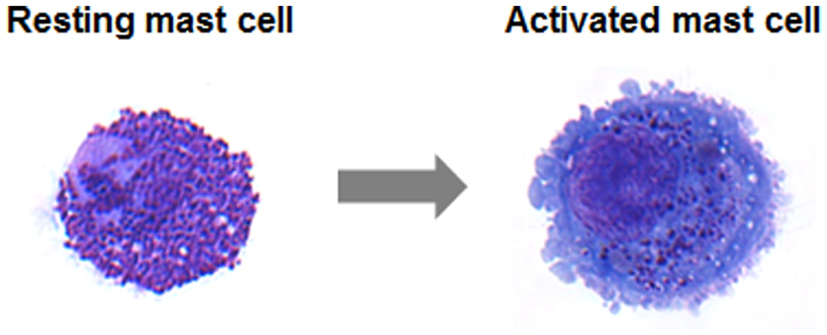What is Mast Cell Activation Syndrome (MCAS)?
Mast cells are sentinels or “guards” able to sense a wide range of threats upon the body (such as infections or environmental toxins). When a mast cell senses a threat, it “activates,” producing and releasing chemical signals (“mediators”) appropriate for assisting the body in managing the threat. In mast cell activation diseases (such as mastocytosis and mast cell activation syndrome (MCAS)), mast cells activate in abnormal ways in response to threats and even activate when there is no threat at all. In such situations, when mast cell mediators are released inappropriately, the reactions by other cells and tissues to those mediators are hurtful, not helpful.
To quote Dr. Theo (AKA – “The Mast Cell Master”), “Mast cells are the “universal alarm cell” that starts the inflammatory cascade. They can be triggered by infection, allergens, environmental factors like pollution, or even emotional stress. Once that happens, mast cells set into motion a series of inflammatory reactions, including the activation of immune cells and the release of tumor necrosis factor-alpha (TNF-alpha), a pro-inflammatory protein, or cytokine.”
In some people, mast cells can become overly sensitive and reactive. Mast cells may be involved in food allergies, allergies to bug bites, celiac disease, Interstitial Cystitis (IC), and heritable connective tissue disorders, such as Ehlers-Danlos syndrome (EDS).
“Mast cell activation disease” is the general term for disease of inappropriate mast cell activation. “Mast cell activation syndrome” (MCAS) features inappropriate mast cell activation with little to no inappropriate mast cell proliferation while mastocytosis features both inappropriate mast cell activation and significant levels of inappropriate mast cell proliferation. There are two principal types of mastocytosis, cutaneous (limited to the skin) and systemic (spread throughout the body), and there are several subtypes of cutaneous and systemic mastocytosis. The most common type of cutaneous mastocytosis is urticaria pigmentosa. The most common type of systemic mastocytosis is indolent systemic mastocytosis. The terms “mast cell disease” and “mast cell disorder” are used interchangeably.
In those who have a connective tissue defect, that defect causes instability of the connective tissues. Some mutations cause more instability than others, such as with Vascular Ehlers-Danlos syndrome (VEDS), or Marfan s. Only research will be able to help us understand the relationship between the mutation(s) associated with one component of our connective tissues to an otherwise normal and functioning component, and how epigenetic changes affects both.
Mast cell activation is linked to some cancers, cardiovascular diseases, connective tissue disorders, inflammation, including inflammation of the brain, allergy and asthma, irritable bowel syndrome (IBS), various skin disease, and other auto-immune diseases such as rheumatoid arthritis (RA) and Lupus. Mast cells are involved in some food allergies. Mast cells and inflammation of the brain are linked to depression, anxiety and other mental health conditions in some patients.
Mast cells can drive both allergic and inflammatory processes. They are a type of white blood cell and are part of our immune system found in our connective tissues.
Mast cell disease can drive auto-immune conditions and seasonal allergies. They may be the link between heritable connective tissue disorders, such as EDS, and autonomic dysfunction (dysautonomia), as well as various conditions that cause chronic pelvic pain in women.
There are both genetic, and environmental components that contribute to conditions that fall under the mast cell activation diseases umbrella. In the autumn of 2015, we learned about a recently identified type of hypermobility EDS that also features a kind of mast cell activation disorder and a kind of dysautonomia. Maybe this new syndrome will be categorized as a mast cell activation disorder or open the door to a new set of conditions to be named.
Stress can be a trigger for mast cell activation. Stress also causes the biggest variance in the presentation of symptoms in almost all of the conditions mentioned above. Stress can be an insult to the body, such as trauma – both emotional and physical – lifestyle choices, and environmental factors that are both in our control and not in our control. Some examples of stress are serious illnesses, alcoholism, toxicity from heavy metals or chemicals, surgery, reaction to medications, anaphylaxis, abuse, and accidents.
To read a full listing of Dr. Afrin’s publications, please go to Full List of Publications by Lawrence B. Afrin, M.D.
To read some of Dr. Theo’s research articles on mast cells and mast cell activation, go to www.mastcellmaster.com
For more information on Mast Cell Diseases, please visit The Mastocytosis Society
Other helpful mast cell sites:
www.mastattack.org
www.mastcellaware.com
***The content on this page has been read and reviewed by Dr. Lawerence B. Afrin. Content is copyright protected and may not be reprinted or republished without permission of the original author. All rights reserved.***






